For Week 8 we were to pitch our ideas and get feedback using the slides created in Reading Week. Unfortunately I was sick on the Monday and couldn’t come in, but determined to get feedback I turned my slides into a google form and sent it to the class discord server seperately.
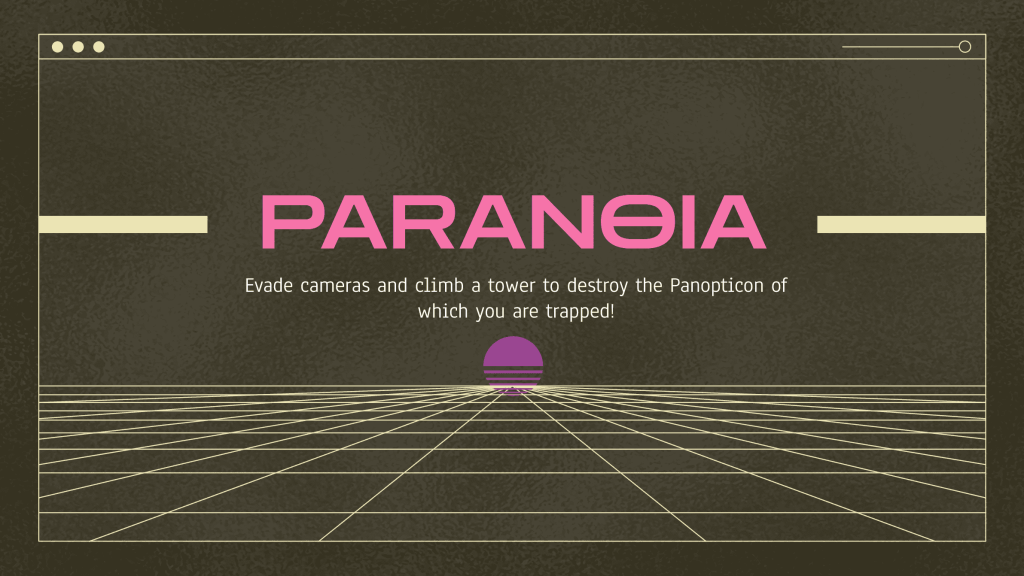
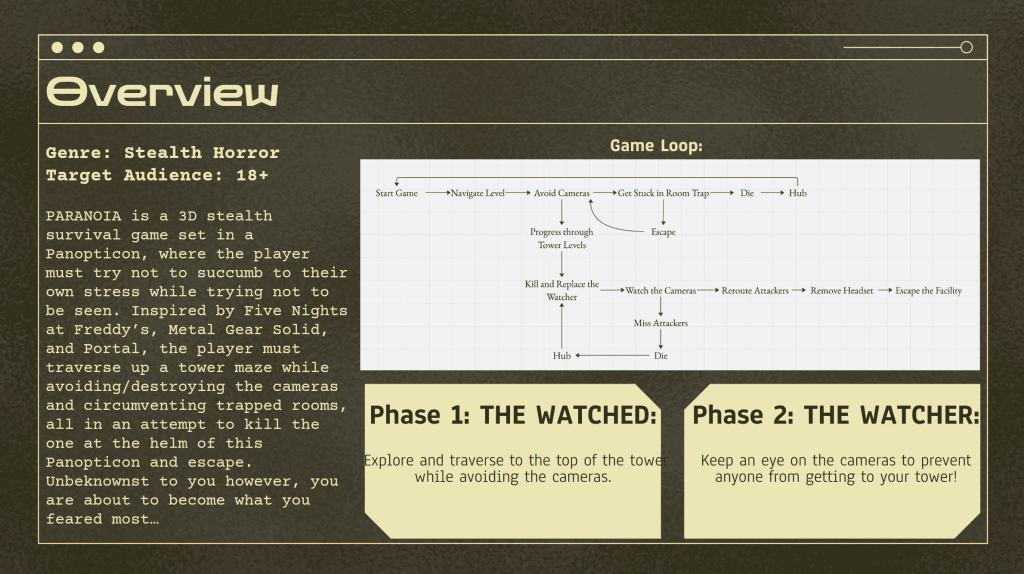
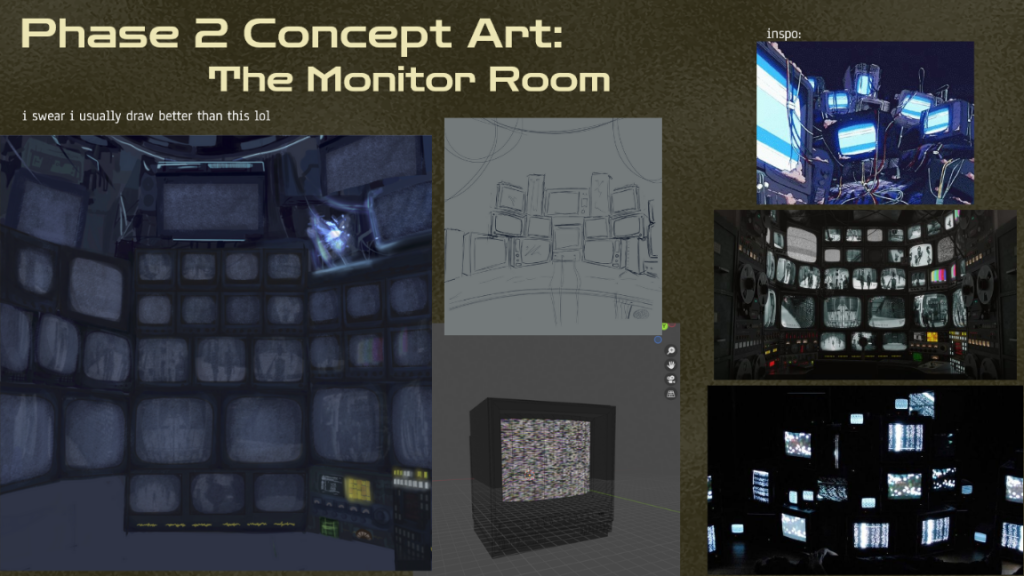
This was my feedback:
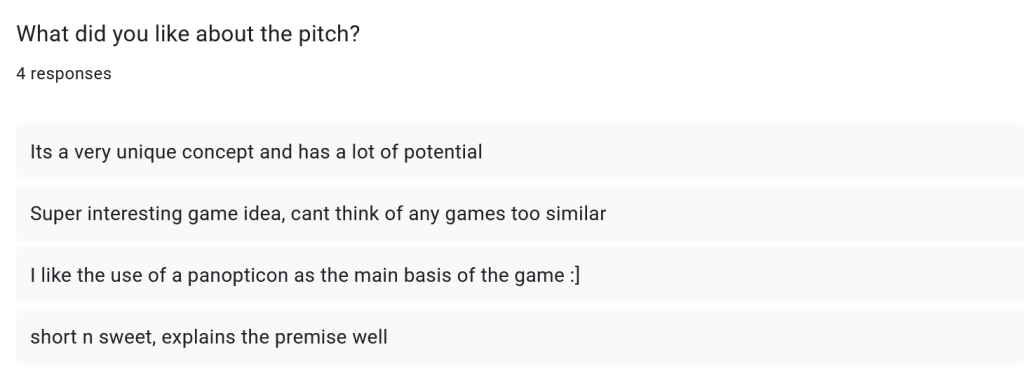
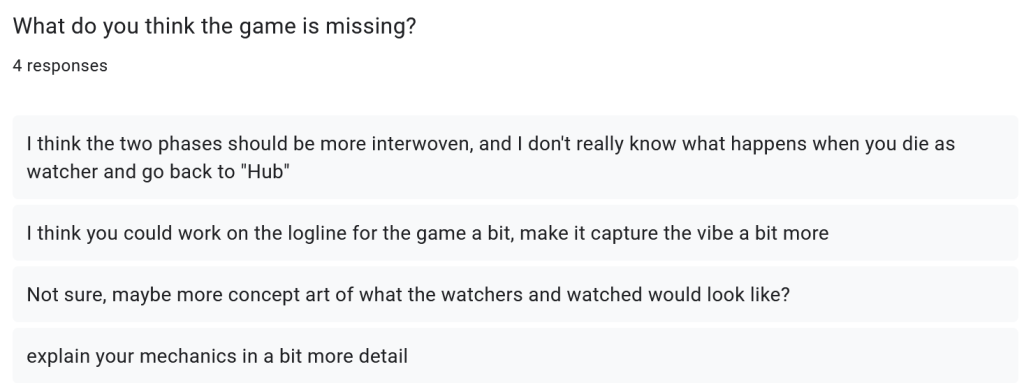
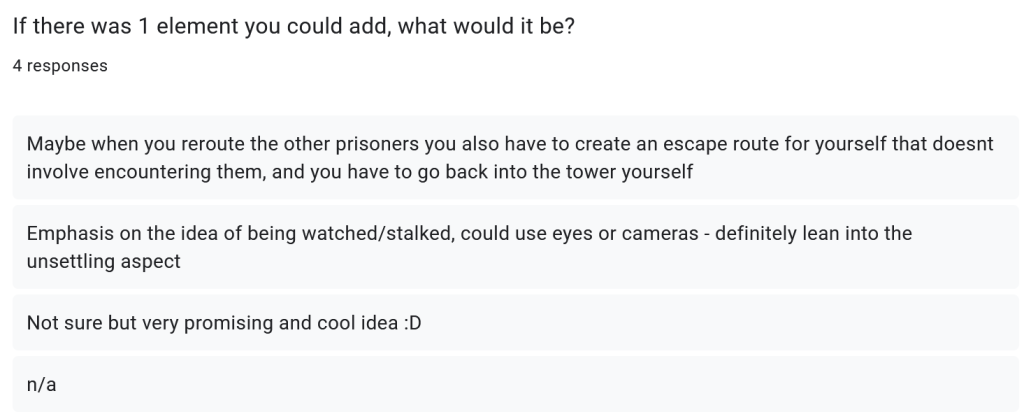

According to this, my new list of criteria is as follows:
- Transition the two game phases more smoothly
- Make clearer what happens after player death
- Needs a better logline
- Concept art of watcher characters needs to be supplied in pitch
- Emphasise the idea of being stalked
- When rerouting other prisoners, you also have to create a path for yourself that you must go down to win the game. This is an idea I have toyed with a little, so now someone else has come to a similar idea I feel more confident in implementing it
Resident Evil (2002)
This week for Videogame Movie Club we watched Resident Evil, another game franchise I am not familiar with. It is based on the Resident Evil franchise (“Biohazard” in the original Japanese) that launched in 1996 for the Playstation, a survival horror that is credited for bringing zombies back into pop culture, as players must shoot zombies to survive in various environments. Resident Evil games are still being made today!
However despite being in the same genre as Silent Hill, I didn’t enjoy the movie nearly as much for a number of reasons:
- Plot
- The plot was… very confusing, and clearly made for people who had already played the games and knew the lore – however, the frustrating thing is, this approach wasn’t required at all! One friend at the club who did know about the Resident Evil lore explained this movie was supposed to be a backstory for the gameworld. This means it had almost zero ties to existing characters, places, and storybeats of the game, and could have widened its audience by unfolding in a way that made sense to newcomers of the Resident Evil franchise. It relied on suspense and action to keep people engaged, but without really knowing the stakes or the world, I wasn’t engaged.
- Characters
- The main character felt very reductive. She was an amnesiac, and consistently relied on the soliders around her to do things for her, and until she began to remember her identity she walked around helplessly in a skimpy red dress and jacket contributing nothing. When she does begin to fight, it happens out of nowhere when she’s backed into a corner, without any training or failures to make any sort of compelling growth.
- The cast felt too large and was too much to keep track of at once, and I only started to remember names and faces in the last act of the movie, when the others had been picked off. Any deaths before then didn’t feel sad as they were just grusome.
- Despite the large cast, there weren’t really any interesting relationships between them. The only one I found compelling that of the main character, and a fellow female solider who was bitten by one of the zombies, as she tried desperately to save her in the final act of the movie once she started to remember who she was.
Since it’s a prequel with no direct tie to any of the games, I don’t have a companion piece to compare it against, however I did watch the first hour of this gameplay of Resident Evil 1 Remastered. It doesn’t bear a lot of similarities, but the puzzle solving and progression system did seem to echo that of the movie!
Jessica Saunders on Audio Design:
Jessica Saunders is a sound designer who was educated with a Degree in Creative Music Technology, and has gone on to work at Codemasters and Rare, and now has started her own company called Salex Games.
What is Game Audio?
The role can be broken down into Asset Creation (which consists of recording, designing, and sourcing) and Implementation (which consists of triggers, events, and optimization). Both of these have their own pipelines, which vary from role to role and company to company.
AMBIENCE:
- Ambience is the starting point, the background noise that sets the scene.
- All rooms have a specific sound/tone
- All sounds must be able to be traced to a Point Source (the sound’s point of origin) so that it can be proximity mapped
- Reverb is important – sometimes it is baked into the ambience, sometimes it is not
- Occlusion is are objects that block noise (eg; walls, doors) and are important to consider
- When creating Ambience, consider: location, geography, time period, gameplay, weather, time of day.
FOLEY:
- Foley are the real world sounds that create depth and realism
- It grounds characters and players to the real world, but doesn’t necessarily have to be realistic – many foley sounds are exaggerated to clue in the player
- Requires a lot of thought and movement study
- When creating Foley, consider: who and what people/players are talking; materials/clothing sounds; when it takes place; location; the furniture and surroundings; how they are moving; weather and elements
WALLA:
- These are crowd sounds and loop groups
- Bespoke to area and reacts to spaces/events
- Do you need it? If there are 5+ people, probably. Use with oneshot dialogue for extra punch
- Treat like ambience in terms of editing (granular sound design)
- When creating Walla, consider: time period, gender ratio, accents/slang, atmosphere, context, where they are, who is there
SOUND DESIGN:
- Anything unreal or something that can be ethically recorded falls under sound design (eg; creatures, explosions, physics, particles, subjectives)
- Can cross over with music and foley
- When sound designing, consider: location, proximity, scale, biology
UI:
- It is more than blips and beeps!! It must cut through the rest of the soundscape
- The sole purpose is to relay information to the player
- Avoid repetition. This will annoy players
- Use a cohesive suite so the player understands what’s happening subconsciously. Happy/sad/neutral tones are key.
- What will fit the world?
MUSIC:
- A sound designer will not be composing the music. Instead their job will be implementation and dealing with pipelines
- Does your composer understand videogames?
- Sound designer and composer are SEPERATE JOBS
- Should/Can you have interactive music?
- When is music diagetic and when is it not?
- Reflects mood, tone, and story beats
DIALOGUE:
- Jobs entails translating from script to screen, working with actors, casting (usually senior members of sound design but can be overseen by other departments, eg; narrative designer)
- Sound designers will be in dialogue editing and post processing and implementation
- Types of dialogue include: combat barks, player thoughts, NPC callouts, handlers types, cutscenes
- Dialogue management is important. There are often thousands of lines in scripts
- A rough pipeline: Animators block out -> Placeholder dialogue -> Animated -> Refined Dialogue -> Re-Animated -> Audio Team
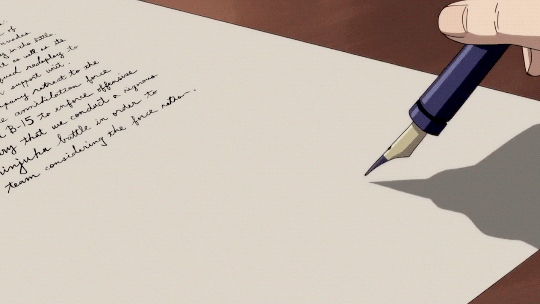
Leave a Reply